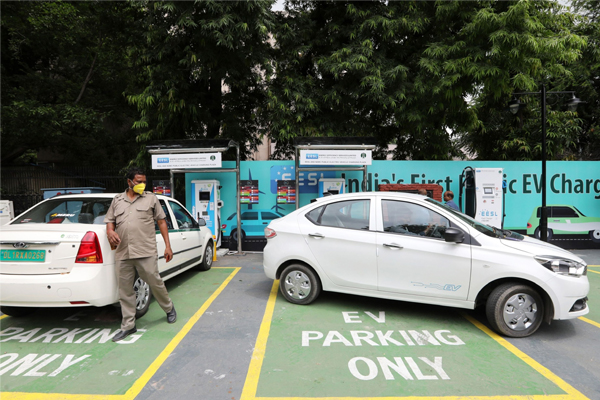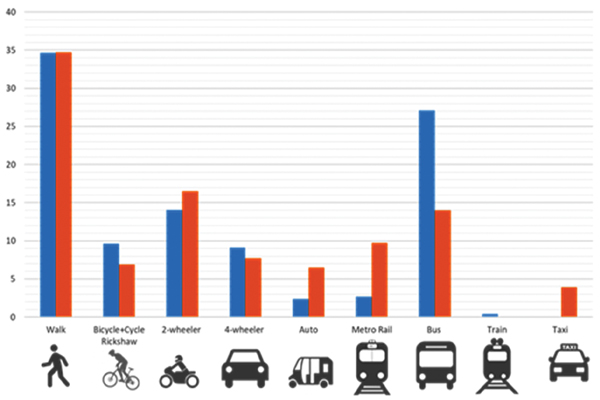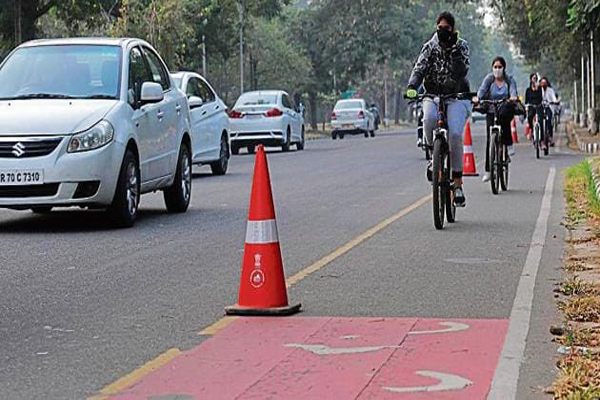
Target 11.2 of the Sustainable Development Goals (SDG) lays specific emphasis on three aspects – sustainability, safety and accessibility of mobility solutions. While the broad contours of what ails the sector and needs to be corrected are well understood, implementing mobility reforms remains a challenge. Particularly for countries like India, prevalent policy environments are heavily inclined towards private car ownership, creation of more and more roads, focus on facilities for private car parking, and lack of a regulatory environment to reduce private vehicular use, writes Nilesh Rajadhyaksha, Project Coordinator, Master Plan Delhi-2041.

Nilesh Rajadhyaksha Project Coordinator Master Plan Delhi-2041
In this context, Delhi demonstrates a marked duality. On one hand, it has one of the densest metro networks in India (fifth largest in the world) and well-networked bus service, while on the other it also has one of the highest private vehicle ownership in the country. The number of vehicles has more than doubled since 2005-06. Share of bus trips and bicycle trips have fallen and while walking remains a predominant mode, this has not been a focus area. A large proportion of metro rail usage remains regional in nature and it is yet to fully serve as a default choice for travel within the city largely due to high tariffs associated with longer trips, issues of last-mile access and lack of integration between land use and transport.
The Delhi Development Authority (DDA) recently released a draft of the fourth master plan for Delhi, setting out agendas and strategies up to 2041. The plan has been prepared with technical support from the National Institute of Urban Affairs (NIUA), to rethink and reinvent the prevalent planning provisions. The draft plan targets ‘low carbon mobility’ as a fundamental objective and sets out numerous hard and soft strategies for achieving this. These can be clubbed under four major buckets as detailed in subsequent paragraphs.

Aligning spatial strategies with mobility
The plan advocates transit-oriented development in a big way – promoting compact mix-use development, reduced parking minimums, active and un-gated built typology, and dense public street networks in all development/ regeneration projects close to transit stations. Select strategic stations with high development potential will be permitted higher FAR and mixing of uses to foster city-level social and economic hubs. Under-utilised land assets such as depots, repair yards, etc. will also be permitted a mix of activities after meeting operational requirements. Such transit orientation will help to bring homes, jobs, cultural spaces and facilities close to mass transit. It will also reduce dependence on private vehicles for daily commutes, minimise vehicular emissions, and adequately leverage the high investments that go into transit infrastructure through value capture.


Share of different modes of transport¹
Complementary improvements in last-mile access, multi-modal interchange and availability of public amenities catering to a wide variety of user groups will be ensured through local planning within 500 m influence area of transit stations. An important feature is the focus on small-format housing in such projects that will result in higher densities close to transit. Further, transit stations that act as regional entry points will be encouraged to provide functions like tertiary healthcare, higher education, hospitality, and logistics to cater to regional needs and restrict thoroughfare traffic passing through the city.
Convergence between spatial strategies and mobility will also be ensured in greenfield areas being developed through land pooling. Primary corridors for future alignment of mass transit routes have been identified upfront and these will be developed as TDRreceiving zones and areas where higher FAR and mix of uses will be permitted.
Encouraging ‘shared’, discouraging ‘private’
While shifting modal choice from private to public transport remains a major concern, the plan recognises the need to support a wide range of non-self owned, motorised and non-motorised options, covering the entire spectrum from metro rails and buses to non-motorised IPT, ondemand or app-based services, feeder systems, gramin sewas, or even future forms such as hyperloops, travel pods, etc. The critical point of differentiation is between ‘shared’ versus ‘private’ modes as a means to achieve sustainability, and the new plan demonstrates a decisive shift in favour of shared mobility.
Also Read: Puducherry Adding Innovation to Affordable Housing
The entire spatial strategy has been shifted to a ‘public transport accessibility levels (PTAL)’ framework, adopted in many global cities – putting public transport at the centre of planning decisions such as allocation of higher development rights, flexibility of mix of uses, mandatory parking requirements, etc.
The focus has shifted to improving systems and facilities for shared modes, so as to improve user convenience and also ensure that more people adopt shared mobility as a preferred mode. The plan provides strategies for improving the network, coverage and services of mass transit networks. It also recommends fare rationalisation, preferential pricing etc. to ensure accessibility to all citizens. It also makes provisions for pick-up/drop and idling facilities, preferential public parking for shared vehicles, adequate accommodation within street design, provision of supporting facilities like public toilets, changing rooms, drinking water facilities, etc. to support other shared modes.
Importantly, the plan takes a hard line on private motorised transport and sets out several disincentives and regulatory measures in this regard. Identification of congestion pricing zones, reduction of free-of-FAR private parking allocations, volumetric and area-based dynamic parking norms, etc. are some of the key provisions aimed at discouraging the use of private vehicles.

Public Bike Sharing (PBS) is an important element of green mobility
Moving towards green mobility
Delhi has been one of the first cities to make a move towards cleaner fuels like CNG for public transport. Delhi Metro also meets a proportion of its energy needs from renewables like solar. There is a need to conclusively move towards greening of other shared modes as well as encouraging people to make greener choices like walking, cycling, personal electric vehicles, etc. both for purposeoriented and leisure trips.
Provisions of the plan include mandatory Walk Plans and Cycle Plans for project sanction, identification of areas/corridors for priority improvement of pedestrian and cycling infrastructure, enhancing user experience and ensuring safety through the use of technology – walk apps, air quality sensors, surveillance for ensuring safety and compliance with pedestrian safety rules, etc. This will help to mainstream walking and cycling as preferred modes for short distances and last-mile.
Special walk/cycle plans are also proposed along eco-cultural assets like buffers of natural drains to create citywide ‘greenways’ that will not only act as nature trails or cultural trails but also provide shortcuts and connections for sustainably moving across large parts of the city. The plan also proposes to improve long-distance cycling infrastructure (still a predominant mode used by the urban poor) along identified routes and major RoWs. Such interventions will facilitate the creation of seamless and continuous networks of walking and cycling rather than ad-hoc area level interventions.
Electric mobility is being promoted in a big way both for shared and private modes. Provisions for charging points in public parking lots, earmarking parking spaces for EVs and providing charging stations within basements, space for battery swapping facilities are some of the provisions included in the plan.
The focus on green mobility is further reinforced through the adoption of complementary planning principles like mix-use, active frontage, walkable street density, restricted block lengths, connected and active public realm, etc. that form the backbone of all spatial, environmental and economic policies of the plan.
Rethinking mobility as an end-to-end service
Citizens experience mobility as a combination of multiple modes, for example, a person may walk to the metro station, take a train to the station nearest to her workplace, and then take a bus for the last mile to reach office. One of the key targets of the plan is to facilitate seamless transfers from one mode to another and efficient movement from start to end of a desired journey. Mobility is thus viewed as an ‘integrated service’ with focus on improving user experience across all modes and their interlinkages or transfer points.
Also Read: Andhra Aims to Achieve Housing for All in 3 years: Ajay Jain
To enable this, the plan recommends development of multi-modal interchange facilities at all mass transit hubs. It also promotes use of digital technology, for ensuring better coordination between different modes and provide citizens with accurate, real-time information and updates (both for motorised as well as non-motorised options) for making their journey shorter, cleaner, and more convenient. Local plans such as influence zone plans will also go a long way in integrating first and last mile connectivity with the major mass transit modes.
In summary
Strategies of the next master plan for Delhi are substantially geared towards achieving the targets set out in SDG 11.2. Application of universal design guidelines is a mandatory pre-requisite for all projects and this will go a long way in ensuring accessibility of public infrastructure. Importantly, mobility assets are also seen as green assets, for example, greenways along natural drains, green roads with plantation, bioswales, etc. This will help build a green-blue continuum over time.
The success of this ambitious plan will depend heavily upon the ability of public agencies to converge their efforts and avoid overlaps/ redundancies. This will require comprehensive planning and institutional integration. The plan recommends constituting a Unified Metropolitan Transport Authority (UMTA) and preparing a comprehensive mobility plan for the city. It is imperative that the city agencies pursue a ‘whole-of-system approach’ and an ‘incremental outlook’ towards mobility management, focusing multi-agency priorities and investments over three time horizons:
Short (7-10 yrs): Focus new asset creation to the development of priority corridors to provide access to upcoming greenfield areas. The major focus should be on improving walkability, last mile connectivity, public amenities, multi-modal transfer facilities, etc. Adopting city-level smart solutions and developing big data architecture should also be a short term priority.
Medium (15-20 yrs): Focus could be on large scale infrastructure in greenfield areas, development of identified strategic transport corridors, development of TODs, Logistics Parks, etc.
Long (25-30 yrs): Complete upheaval of legacy systems, replaced by technology-enabled and sustainable transport systems.
Further, the role of citizens and other local stakeholders in enhancing mobility cannot be understated. The plan recommends local community action in the form of tactical urbanism initiatives (street reclamation, play streets, etc.), place-making, vigilance against encroachers and violators of traffic norms, participation in walkability or safety audits conducted by public agencies, and so on. Delhi’s citizens and planners often complain of congested roads and traffic logjams; a symptom that has been considered an impediment to the high growth and densification of the city. However, to use a medical analogy this blocking of the city’s arteries is the result of poor and unhealthy lifestyle choices and the solution does not lie in creating more road space or more private parking facilities. The condition is reversible if the recommendations of the plan are implemented and Delhi can potentially set the blueprint for megacities to move towards more efficient low carbon mobility solutions.
1. RITES 2007, DIMTS 2018; Analysis: NIUA
Be a part of Elets Collaborative Initiatives. Join Us for Upcoming Events and explore business opportunities. Like us on Facebook , connect with us on LinkedIn and follow us on Twitter, Instagram.











